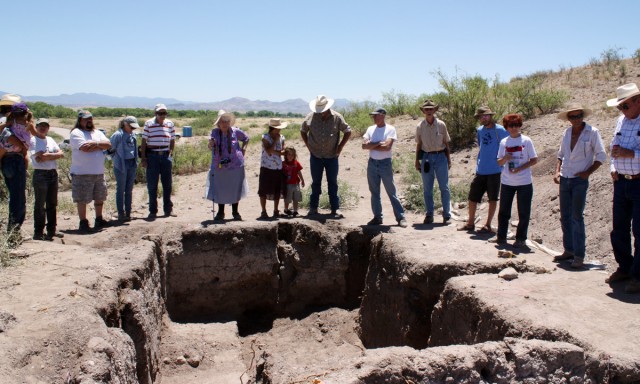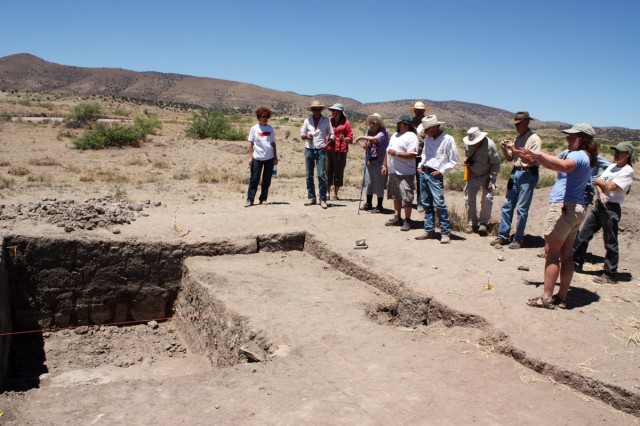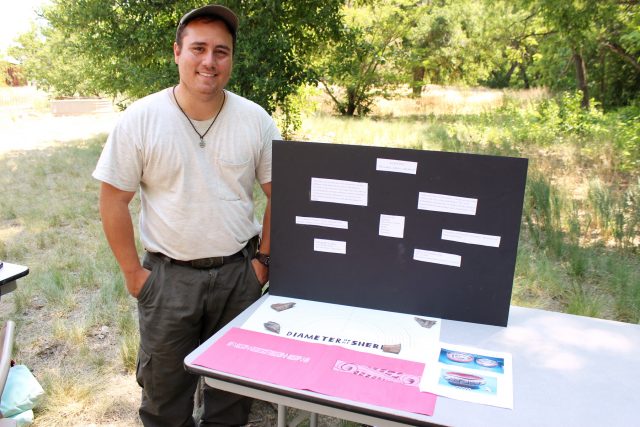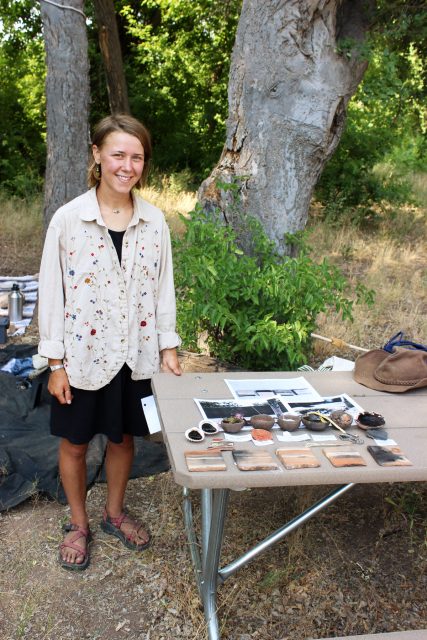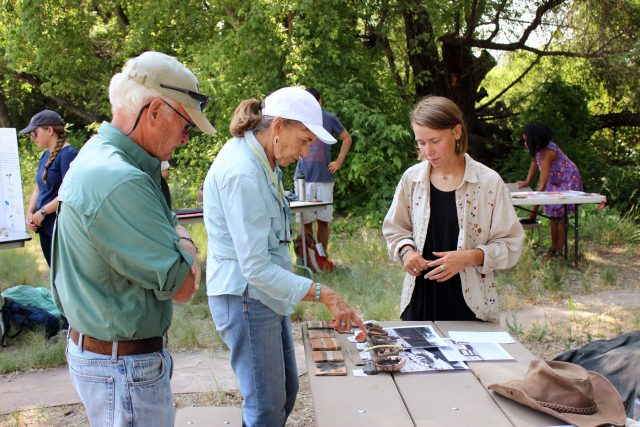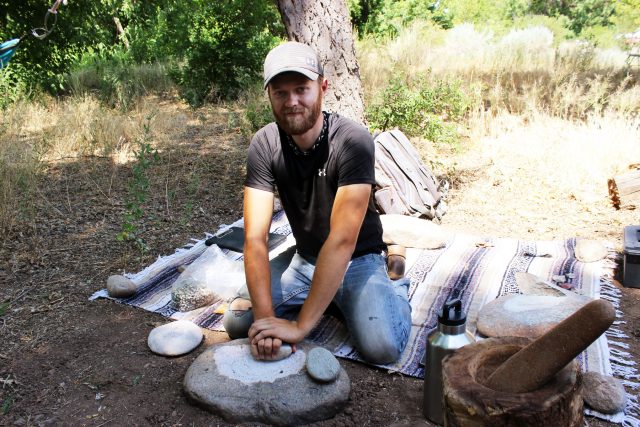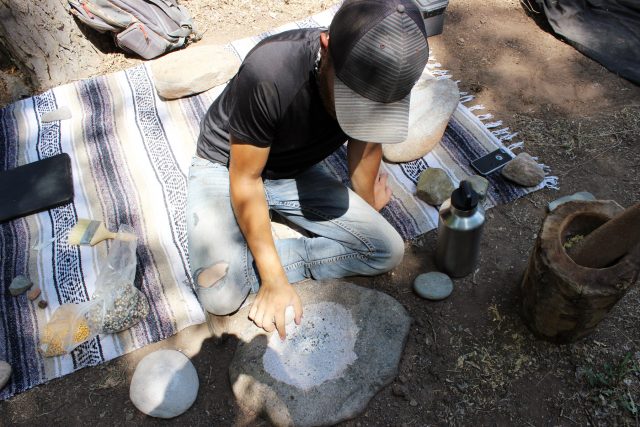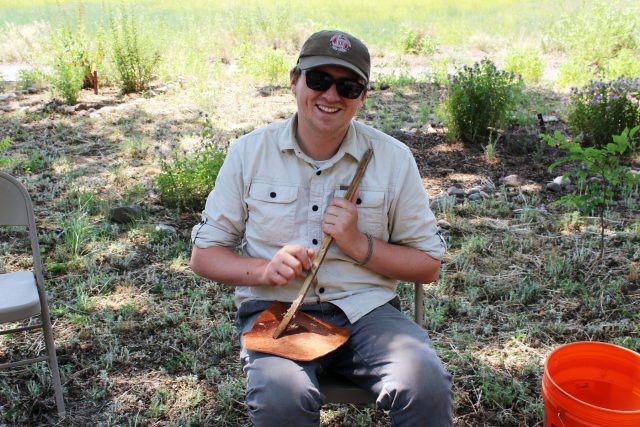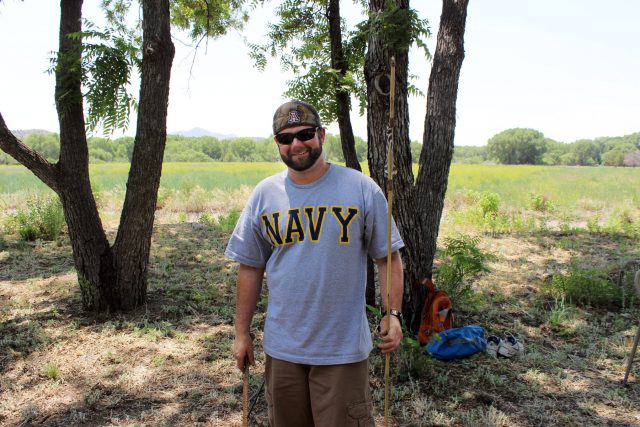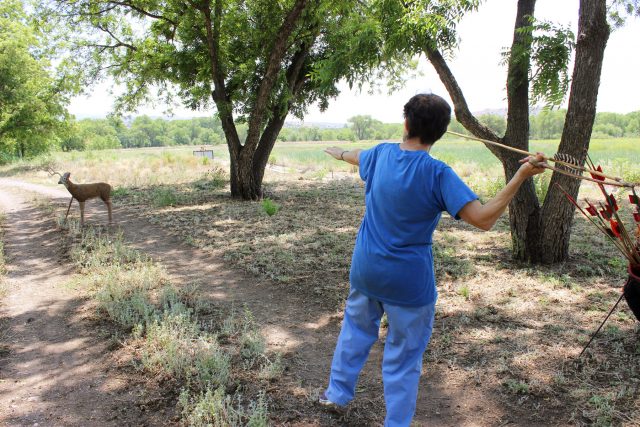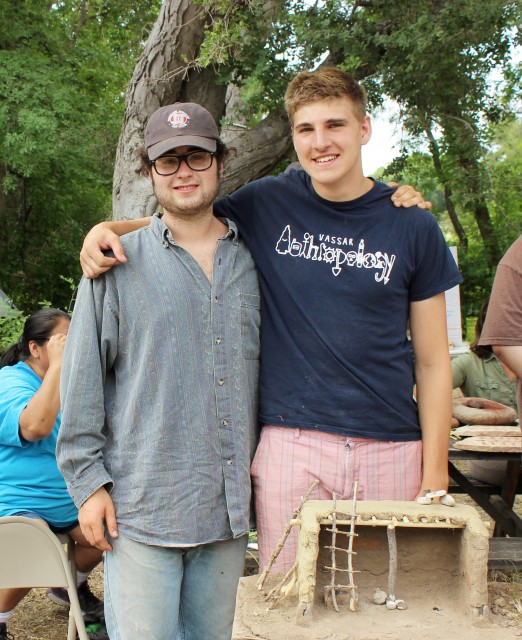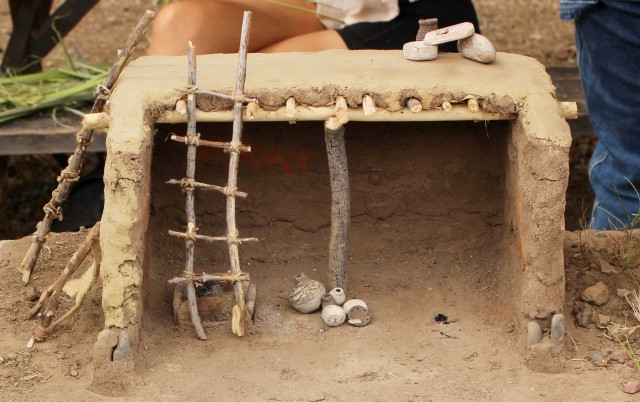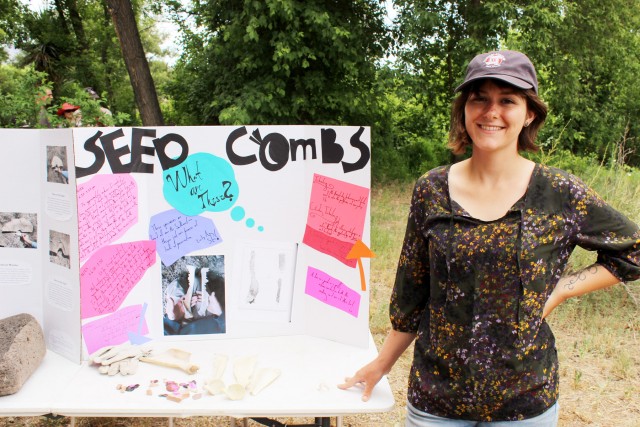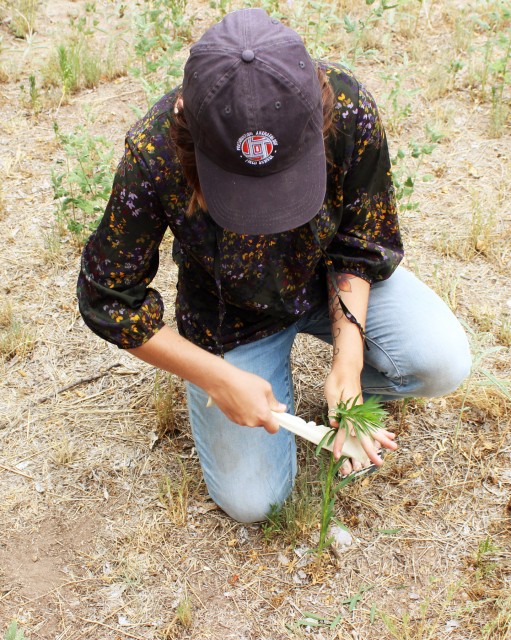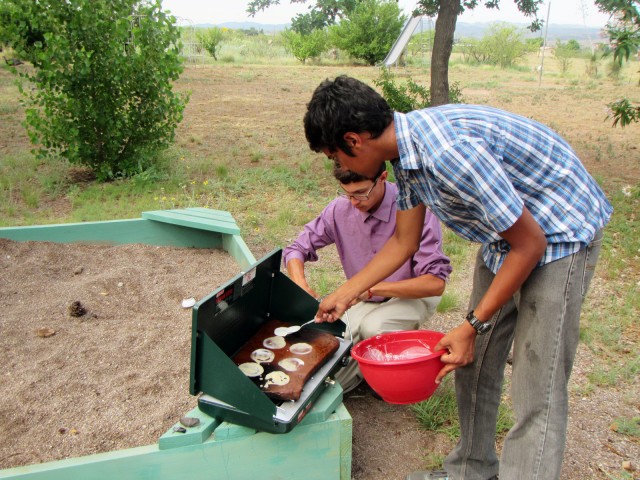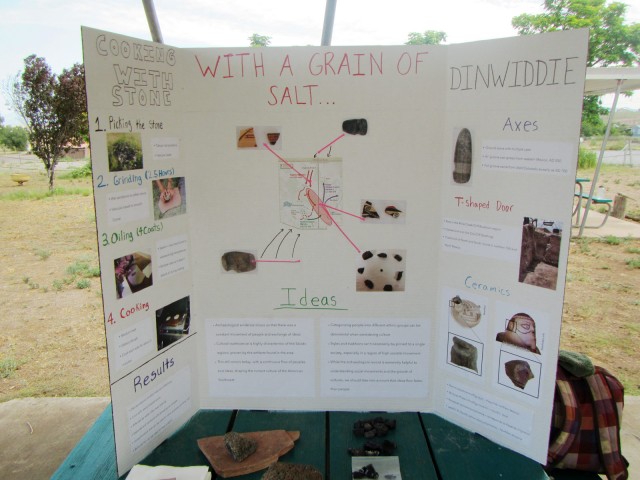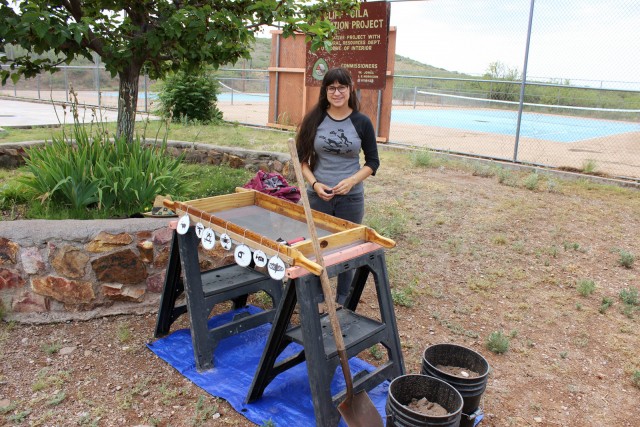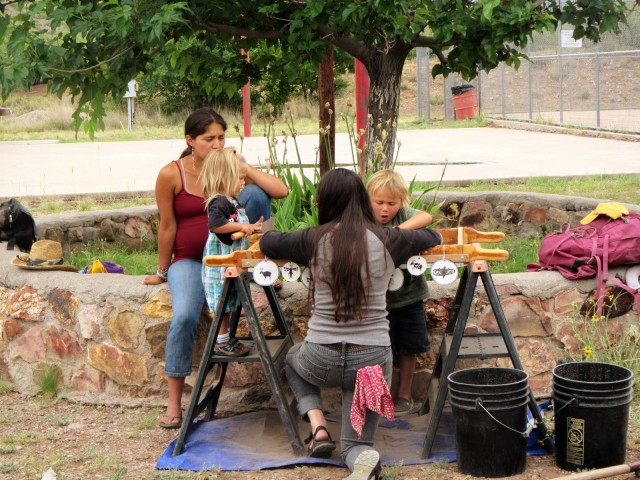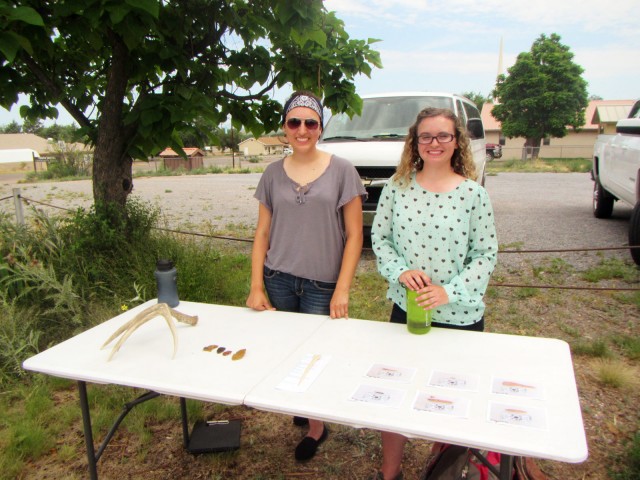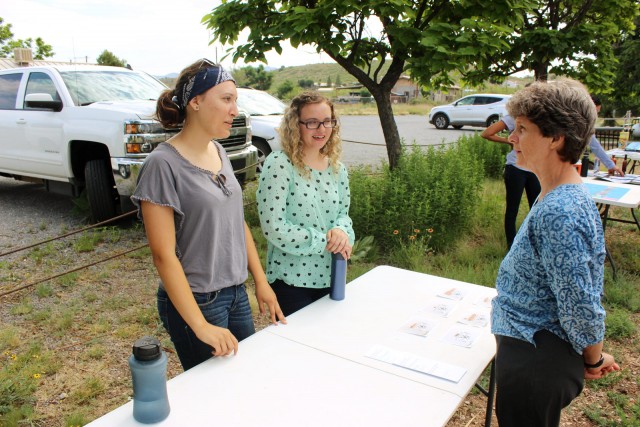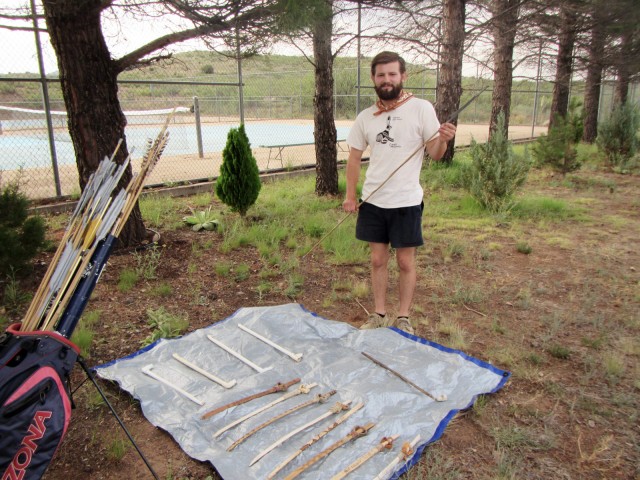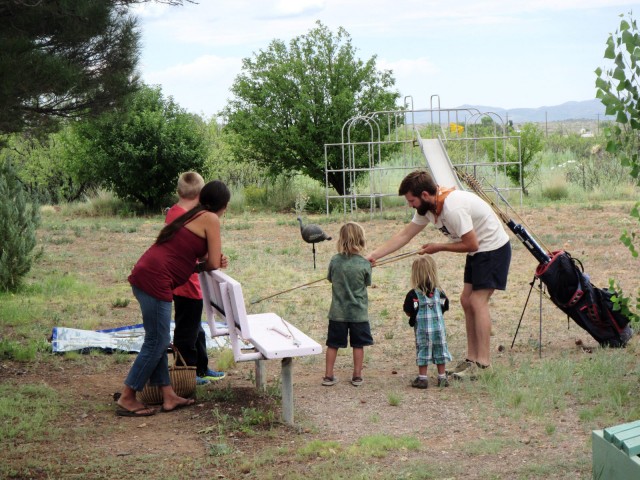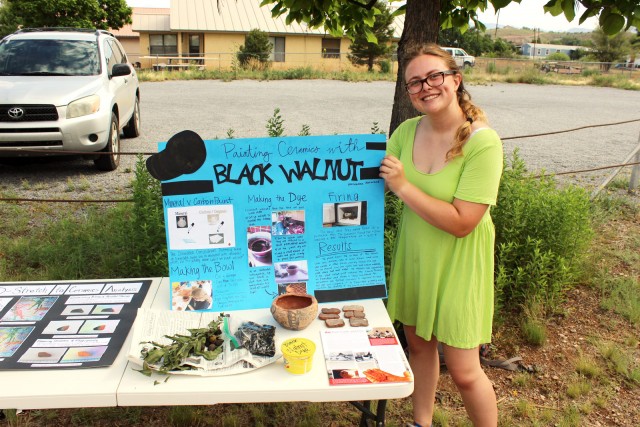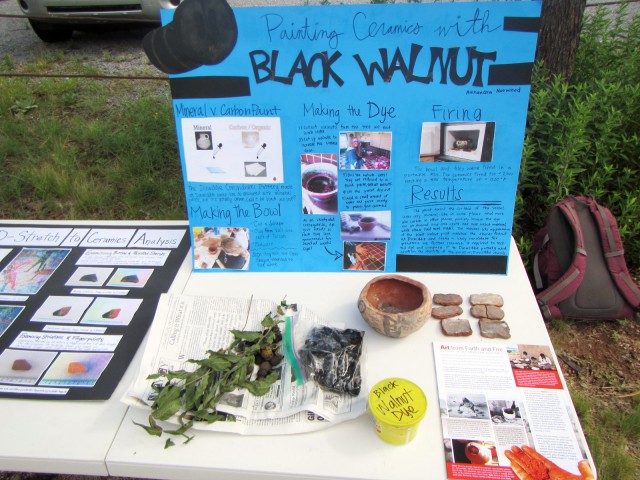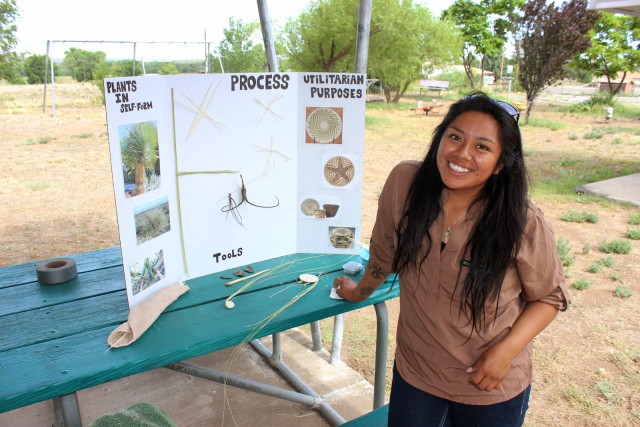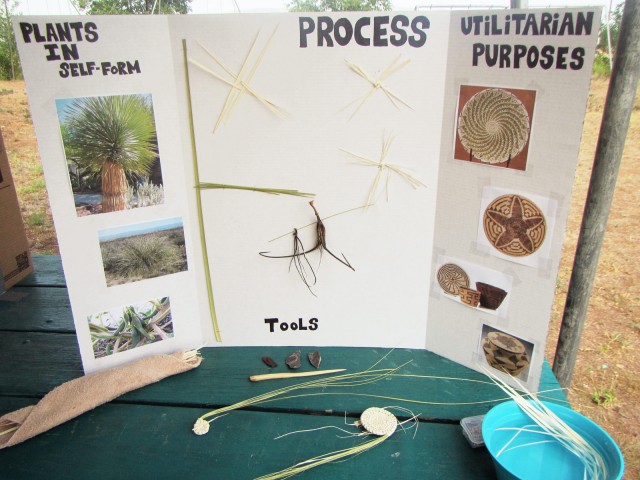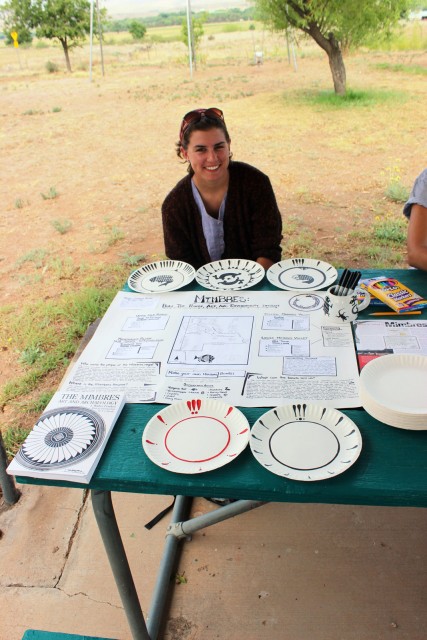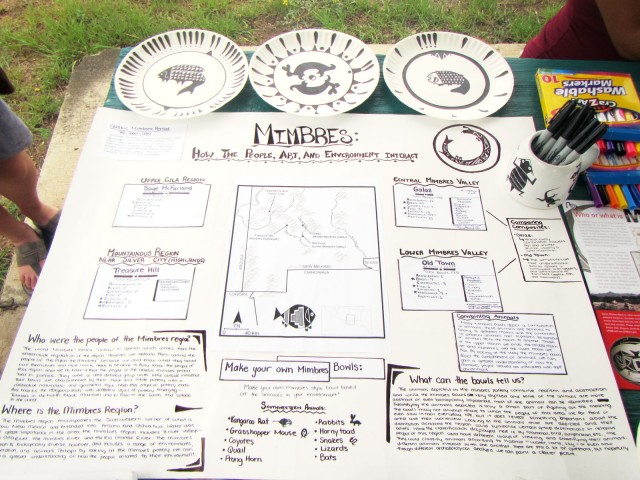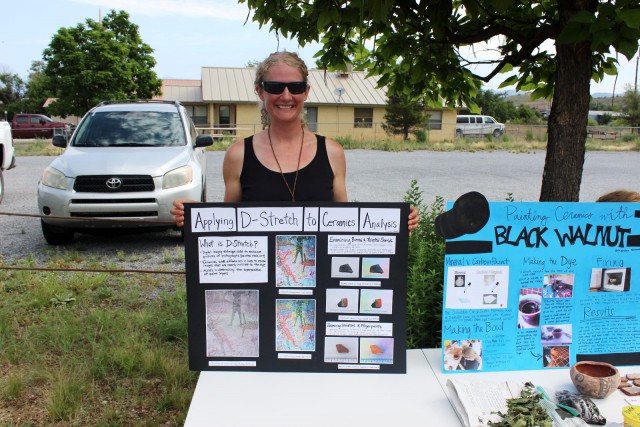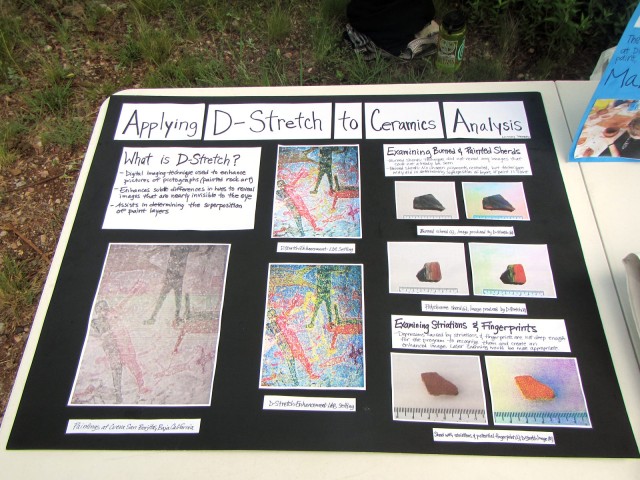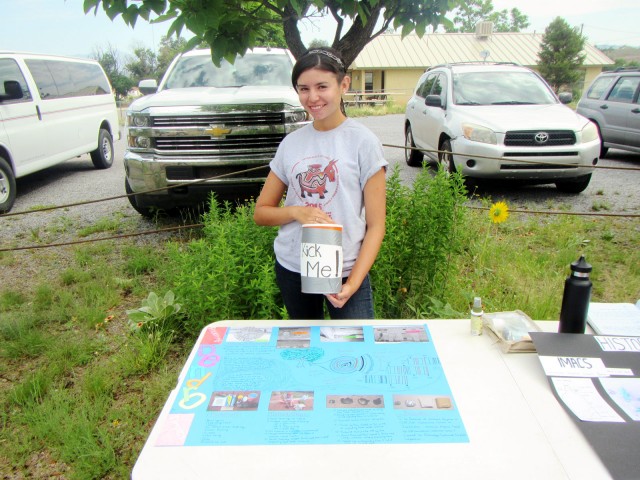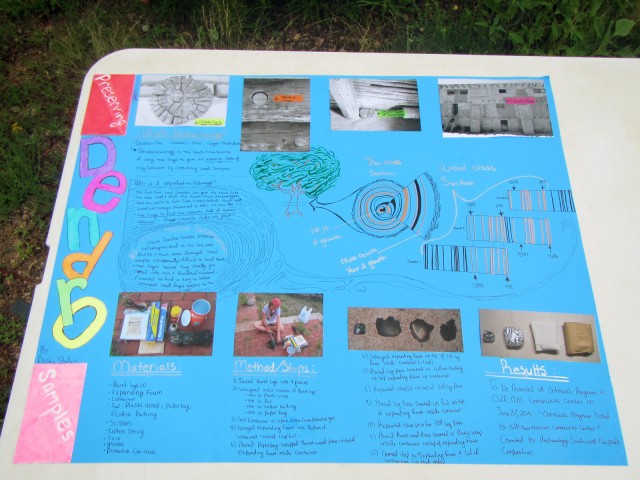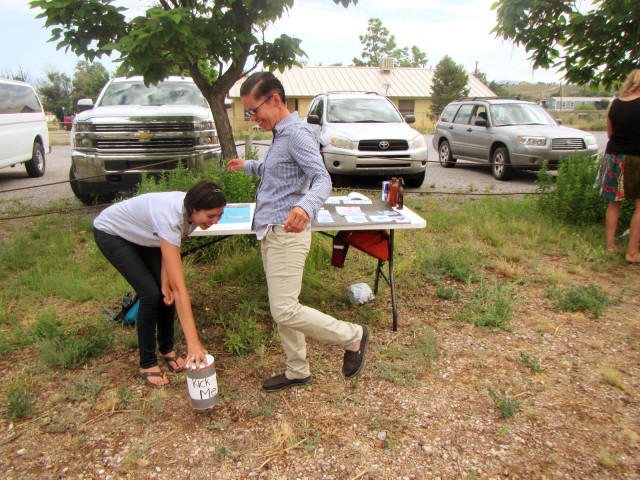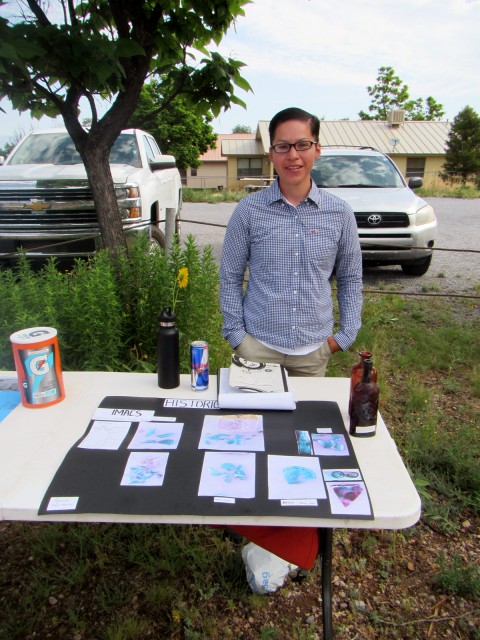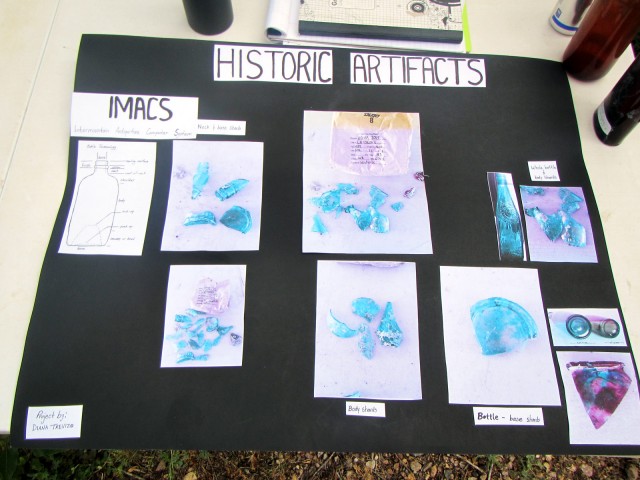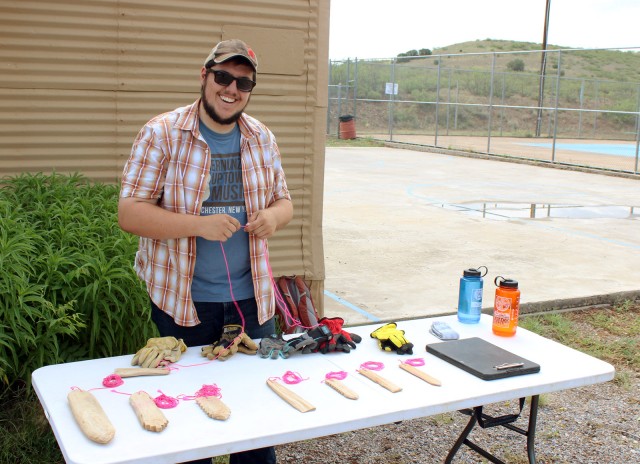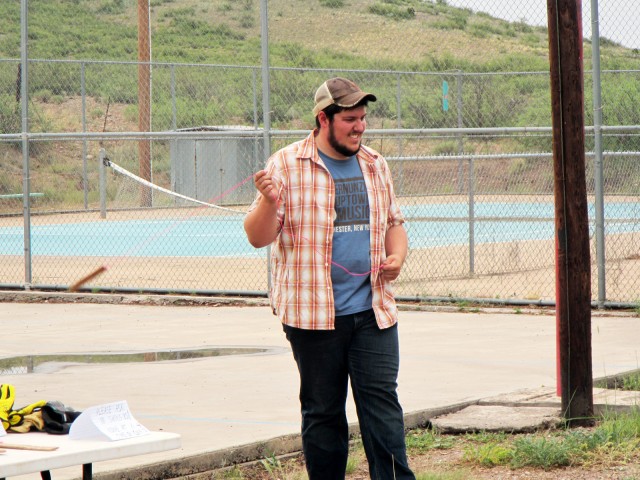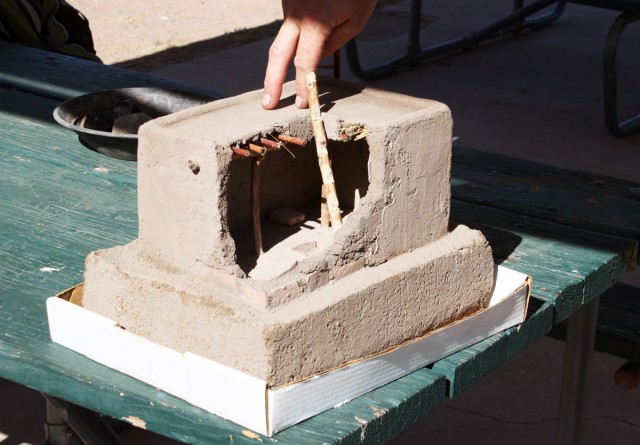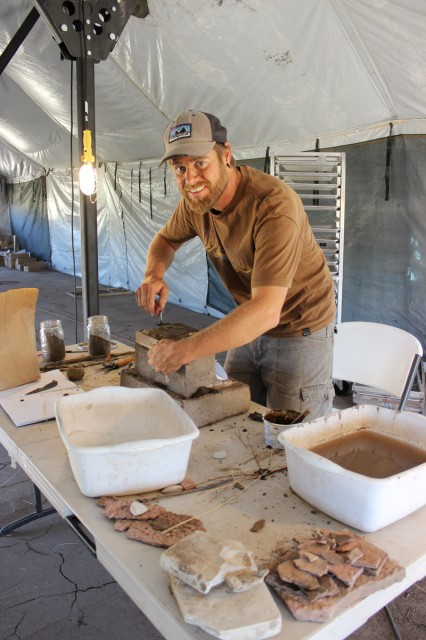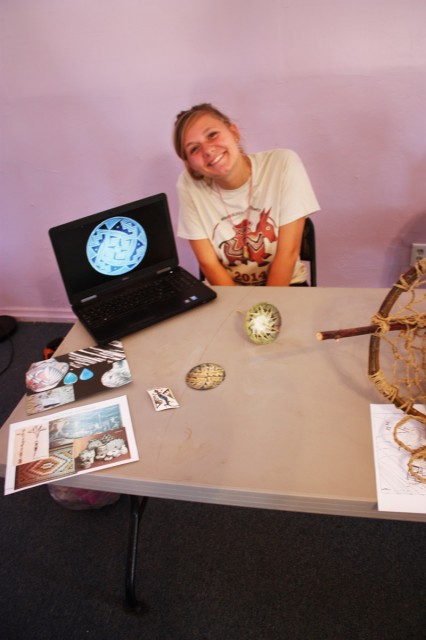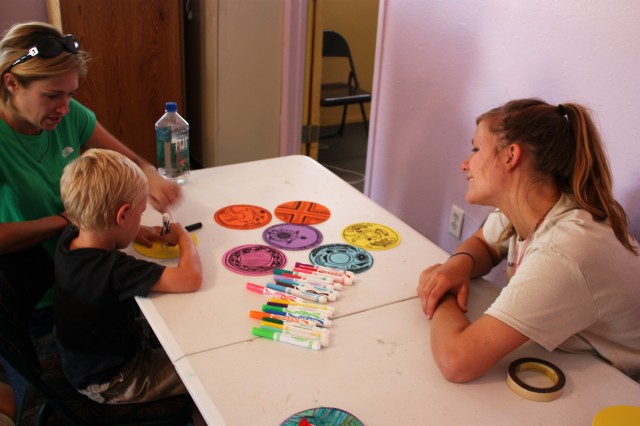2017 Student Outreach Projects
On June 24, 2017, students in the Archaeology Southwest/University of Arizona Preservation Archaeology Field School shared their research with area residents at the Gila River Farm site in Gila, NM.
Sam Banderas, Riverside City College, CA
My outreach project focused on the relationship between serving vessel rim size, dimensions, and decorations and feasting in the Southwest.
Sophia Draznin-Nagy, Mills College, CA
For my project I explored the relationship between clay and pigments by making a series of tiles with experimental organic and mineral pigments. I learned about the firing process and how different variables (including temperature and time) affect the outcome.
Dylan Fick, Arizona State University
My project examined the arid land adaptations used by people in the Upper Gila area in comparison to those from other parts of the Southwest. With interested visitors I discussed Mogollon architecture and land use practices and the contributions of migrants from the Kayenta region to the Salado archaeological culture area.
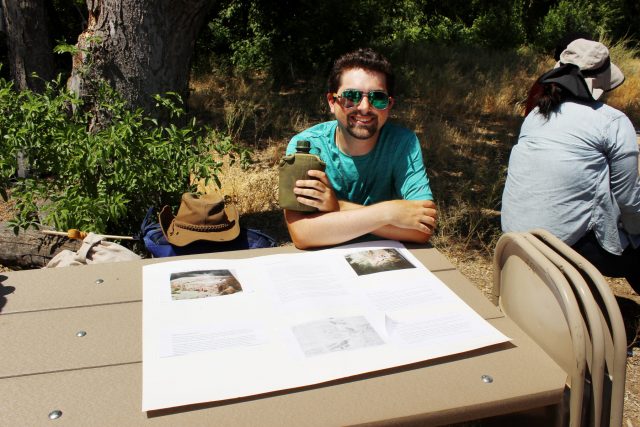
Karla Glagow, California State University, Los Angeles
My project concerned the animal iconography on Classic Mimbres bowls. I examined the locational patterning of bowls bearing bird and insect images within Classic Mimbres archaeological sites, and found that some sites show differences in the distributions of bowls with these images.
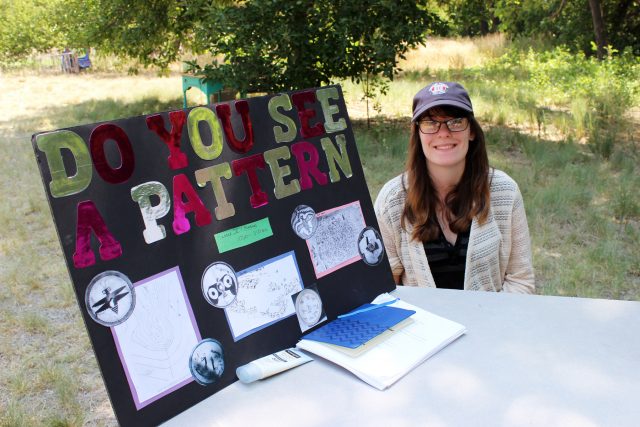
Ashley Huntley, University of Cincinnati, OH
My outreach project concerned a Mimbres “mobile” found in a cave in either the upper Gila area or the Mogollon Highlands, an object also shown on Classic Mimbres bowls. I researched this item and examined the work involved in making wooden figures somewhat resembling those on the original item.
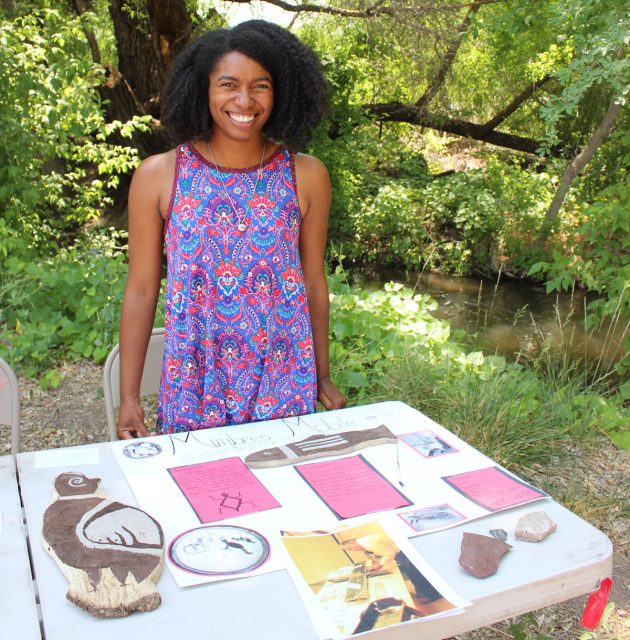
Susie Johnson, Utah Valley University
For my project I studied the process of making bone gaming pieces and the effort required to create them. By reproducing these items I discovered that they required much time and effort to make: I spent 7 hours creating one game piece.
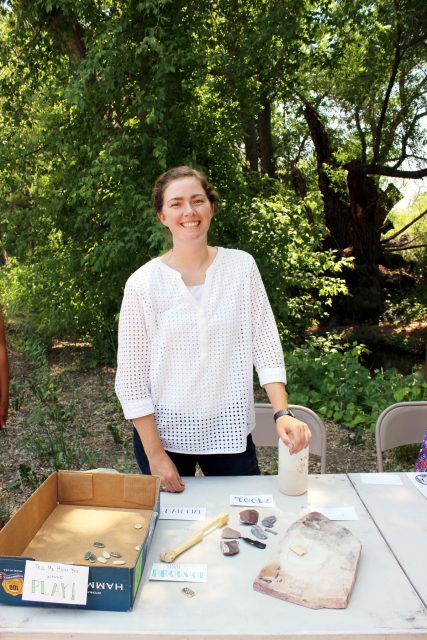
Chris La Roche, Pima Community College, AZ
My outreach project explored possible technologies and methods involved in the manufacture of stone and ceramic pipes present in the Tucson Basin during the Early Agricultural period. I learned about the properties of different materials, tools, and their uses as well as the firing process.
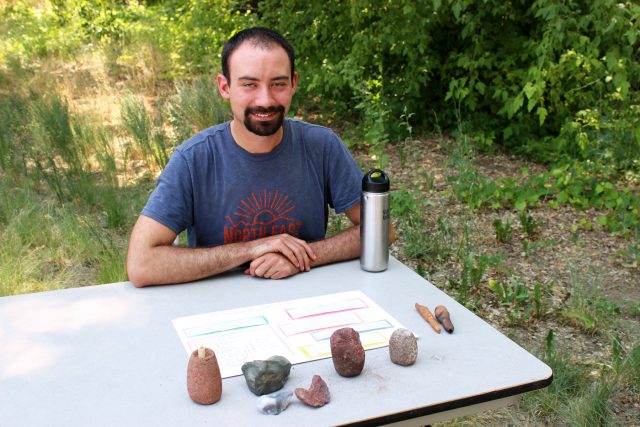
Johnny Schaefer, University of Missouri
For my outreach project I experimented with the process of making and using ground stone manos and metates. I learned about which materials work best and are least suitable, the hardships of manufacture, and how different varieties of corn break down and how much flour they yield.
Emily Tarantini, Mount Holyoke College
My project concerned ancient jewelry, figurines, and fetishes. I discussed some of the archaeological examples of jewelry and figurines found in the local area around Cliff, NM. I also discussed modern examples of fetishes from Zuni Pueblo.
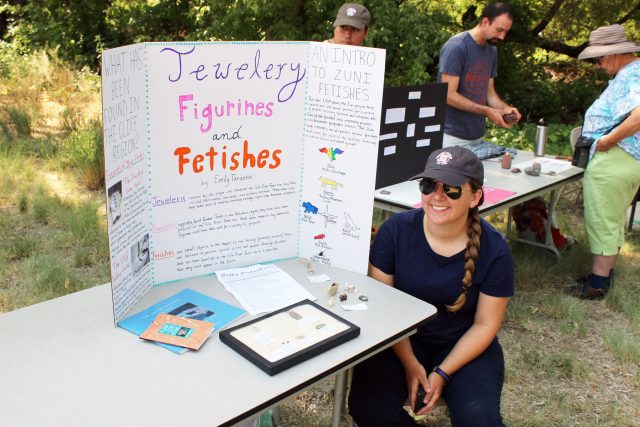
Taylor Picard, Humboldt State University, CA & Stephen Uzzle, Cochise College, AZ
Our outreach project examined how the atlatl was constructed using stone tool technology by creating atlatls using stone tools. We also discussed the various components of the atlatl and the darts used with it. We taught visitors to use one to throw darts, and discussed some of the different lines of evidence used to understand atlatl use in ancient times.
Thank you to the Nature Conservancy and Martha Schumann Cooper for their support during the Archaeology Fair and our excavations; the Davises, our wonderful hosts in Cliff; our friends and neighbors in the Cliff/Gila area; Jaye Smith for her generous help during the fair; and the students and staff of the 2017 Preservation Archaeology Field School for their hard work.
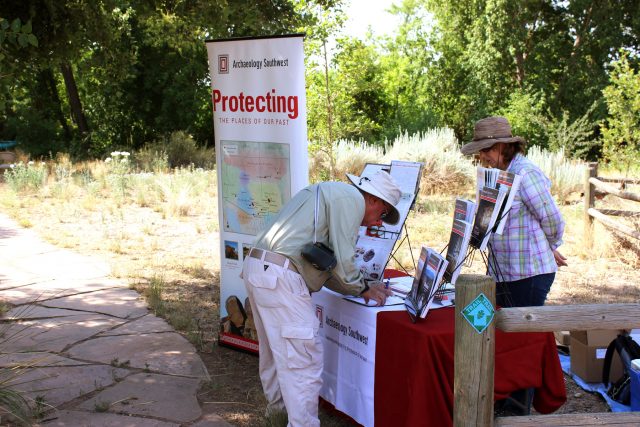 |
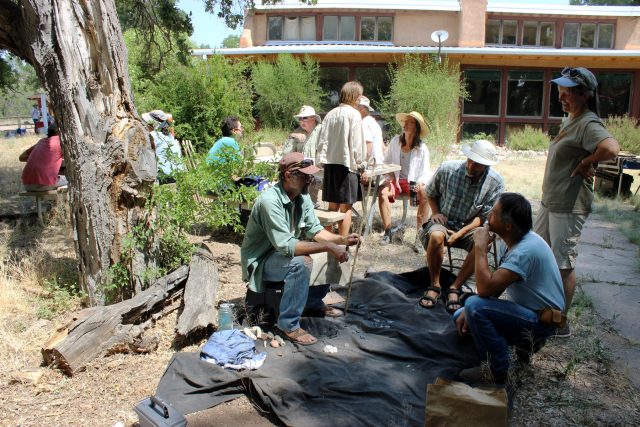 |
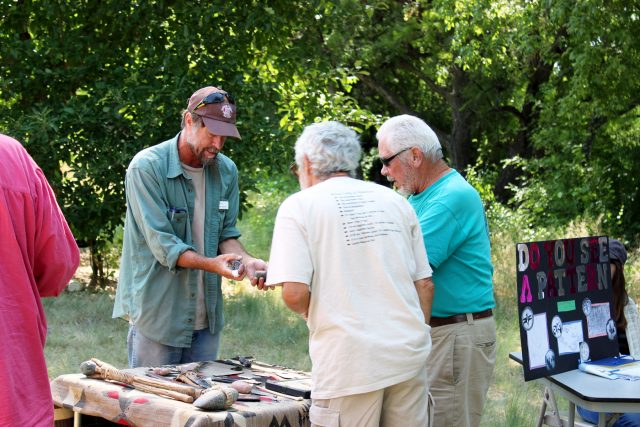 |
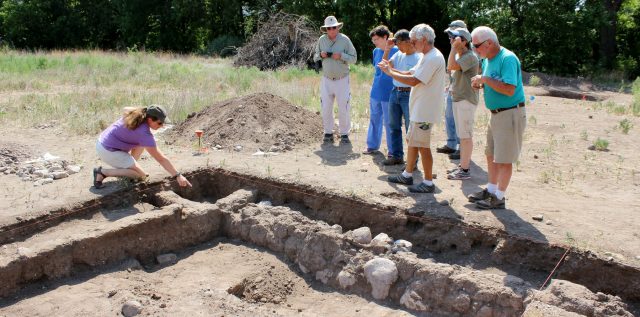
2016 Student Outreach Projects
On June 25, 2016, students in the Archaeology Southwest/University of Arizona Preservation Archaeology Field School shared their research with area residents at the Gila River Farm site in Gila, NM.
Daniel Agudelo (University of Michigan)
My project was based on archaeological ethics and how to run a successful archaeological field project. These two concepts were presented by making visitors players in a board game with a layout based on Mimbres Black-on-white pottery designs and replicas of prehispanic bone dice. Players rolled the dice to move around the board, and then were asked questions based on site ethics and running an archaeological project.
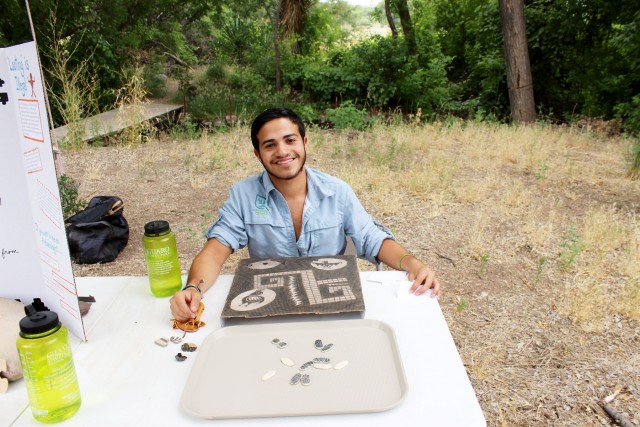
Jonathan Alperstein (Vassar College, NY) and Conner Awayda (University of Buffalo, NY)
We constructed a scale model of an adobe room in the style of Cliff phase (AD 1300-1450+). We experimented with different combinations of clay, sand, and straw to prevent the adobe from cracking as it dried. Our replica structure incorporated construction details used in the Cliff phase, including cimiento stone foundations, adobe walls, and a roof made of wooden vigas, bark, and adobe.
|
|
|
Peter Babala (Santa Rosa Junior College, CA)
My project concerned the effect of core preparation on stone flake size and tool-making potential. I asked archaeologist Allen Denoyer to reduce four comparably-sized cores, two rhyolite and two obsidian. I measured the resulting flakes and rated them based on their potential for making tools. Flakes were rated on a scale of 1-4, with 1 being the best. Two of the cores (one of each material type) were prepared with the intention of producing flakes that could either be used without farther working or reworked into tools, and two cores were reduced without any advance preparation. I concluded that intentionally shaped cores make better use of raw material.
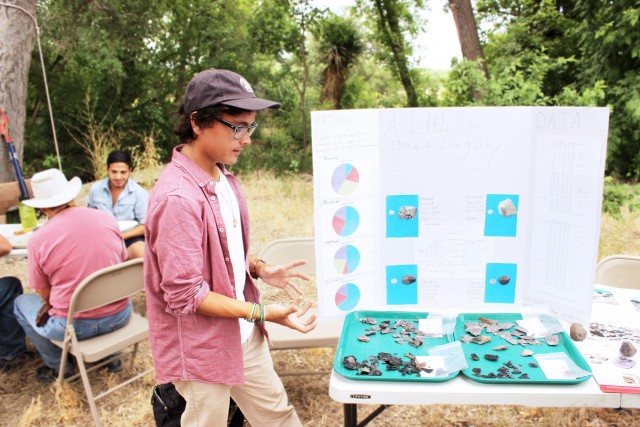
Carolyn Barton (University of South Florida)
My project focused on a comparison between kill holes in ceramics and those in metates. I examined where, when, and how kill holes were made in these items. I also tried to understand the symbolism behind them in order to link this material culture with past people’s ideas.
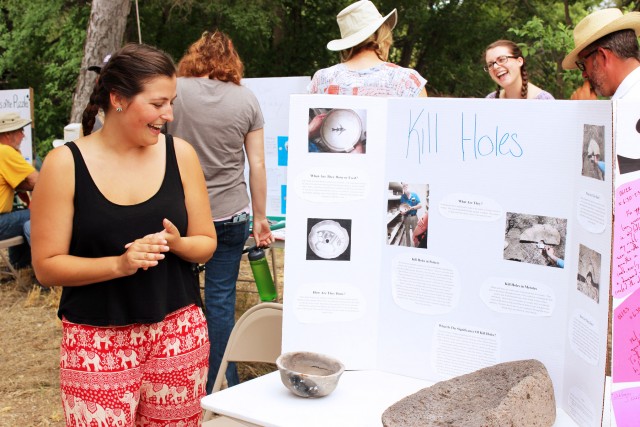
Lexie Bennicas (University of Hawaii Manoa)
The purpose of my project was to help people understand how much we can learn from diagnostic artifacts when they remain in context on archaeological sites. My intention was to help encourage people to leave artifacts where they are found and not remove them from sites. In an area so filled with archaeological sites, this type of education is particularly important.
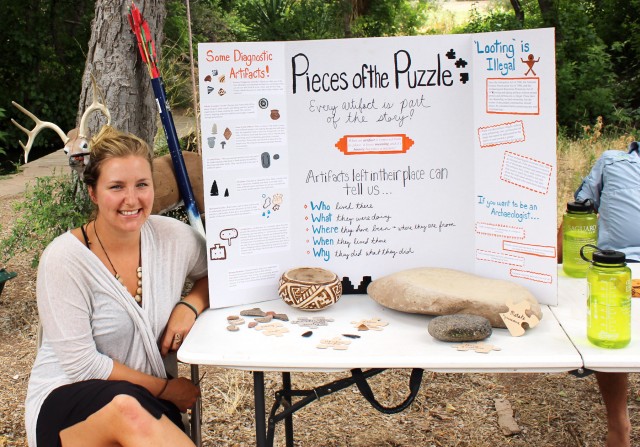
Kaitlyn Cometa (University of Delaware)
I performed an experiment testing Antelope Creek obsidian to see whether one can observe the difference between poor quality and good quality obsidian based on the appearance of the cortex. My hypothesis was supported: the obsidian with matte brown cortex was of good quality for flaking, and the shiny black nodules did not produce good-quality flakes and would often explode when knapped.
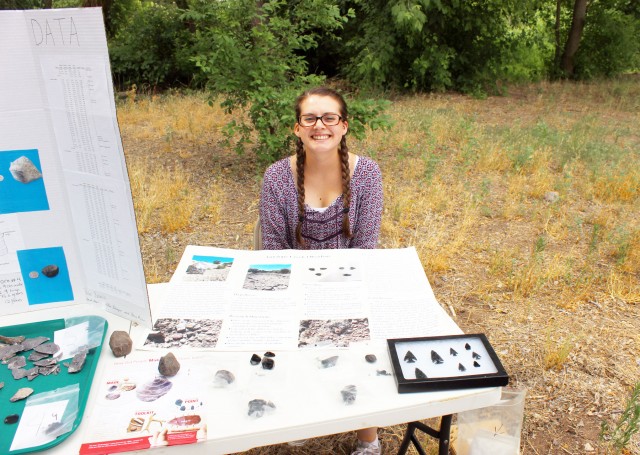
Patrick Depret-Guillaume (University of Virgina)
One of the most interesting artifacts we recovered this field season was a ground stone mano with a hole pecked into it. Ground stone specialist Jenny Adams speculated that it may have been used as a lamp. To test this idea, I made two similar artifacts out of soft volcanic tuff. I used lard as fuel (as an analog for deer or bear fat). For the wick, I substituted industrial hemp fiber for yucca. Although the lamps worked, I concluded that the artifact was probably not used for illumination based on morphological attributes like the depth of the basin.
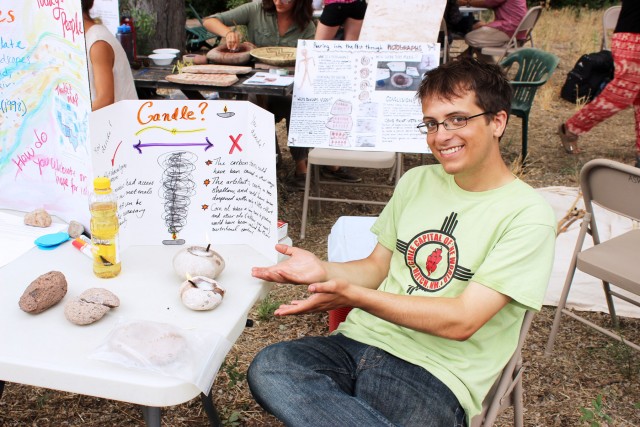
Lara Fields (Bryn Mawr College, PA)
My project tested the consistency and durability of three different pigment recipes for pictograph paint. I compared the efficacy of water, corn oil, and lard for binding the paints, and created a brush using a yucca leaf. I then painted three pictographs on sandstone slabs, each with a separate recipe, and compared the color and residue of the images after three days. This project taught me that even the simplest products can last a lifetime.
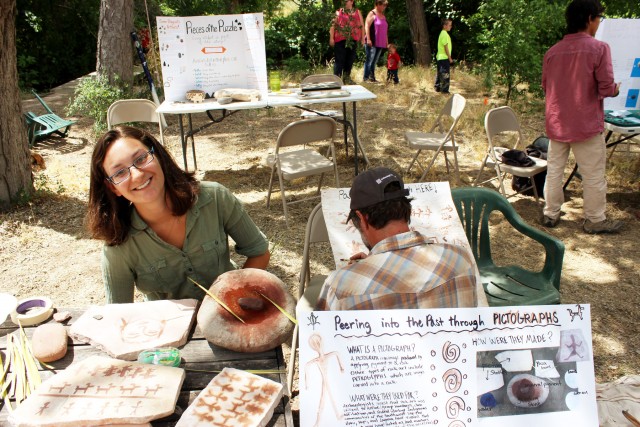
Katie Jacobson (University of California Santa Cruz)
I wove a pair of sandals out of yucca that resembled prehispanic examples. It took several unsuccessful attempts, but I eventually was able to make them. I also presented research on ancient footwear based on archaeological examples and ethnographic accounts. Items that don’t preserve except under exceptional circumstances can still be great sources of information on the past.
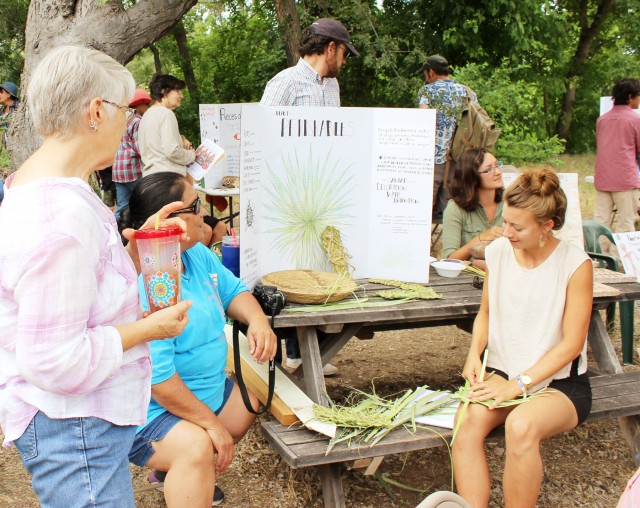
Alyssa Kyper (Eastern New Mexico University)
For my project, I ground teeth into an elk scapula to replicate an uncommon artifact occasionally found in Early Agricultural Period archaeological sites. I experimented with different materials for grinding to make the tool, and had the most success with sandstone. To test the idea that these artifacts may have been used as seed combs, I ran my replica through local flora to see whether it removed seeds from plant stalks. This action produced wear similar to that seen on archaeological examples.
|
|
|
Emily Marturano (University of Pittsburgh) and Lindsay Romo (Cochise College, AZ)
The great kiva at the archaeological site of Ormand Village was excavated in 1965-66, and was unusual in having four walls all constructed differently. There was no evidence of a roof or a central post hole, and the structure was emptied before being abandoned. We chose to research this structure because it was from the same time period and general location as the site where we excavated this year. Our project presented information on the great kiva and a model of the structure.
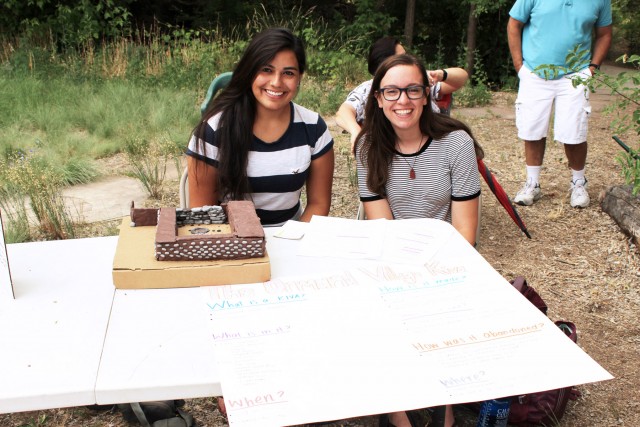
Elissa McDavid (Hendrix College, AR)
My project was about how people in the past symbolized rain, and how current people still do this as well. I presented research regarding Southwestern monsoon patterns and their importance today and in the past. I also showed examples of ancient rain symbols, and asked people to write down ways they hoped for or celebrated rain.
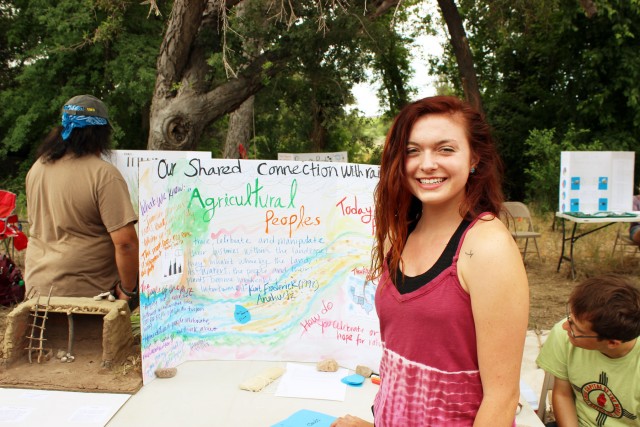
Adam Sezate (U.S. Naval Academy, MD)
My project focused on replicating the manufacturing process of prehispanic stone pipes. I used flaked stone drill bits to peck and bore out the tobacco chamber and mortice, and used sandstone to shape the exterior of the pipe. My goal was to be able to produce smoke “clouds,” which are still used in Native American religion today.
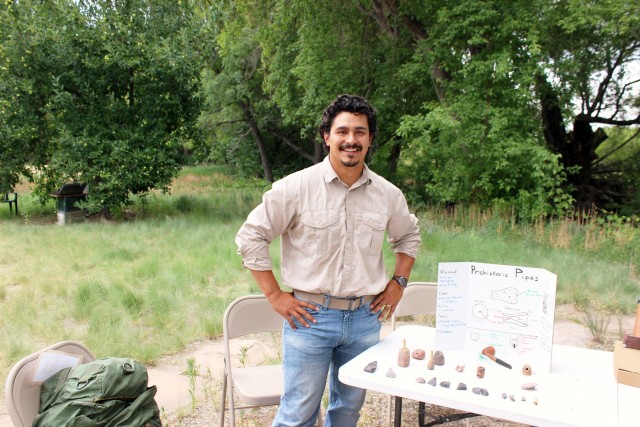
Thank you!
We thank Martha Cooper and the Nature Conservancy for their support during the Archaeology Fair and throughout our 2016 field season; the Davises, our wonderful hosts in Cliff; our friends and neighbors in the Cliff/Gila area; and the students and staff of the 2016 Preservation Archeology Field School for their hard work.
2015 Student Outreach Projects
On June 27, 2015, students in the Archaeology Southwest/University of Arizona Preservation Archaeology Field School shared their research with area residents at the Gila Library and Community Center.
Alexander Ballesteros (Northern Arizona University) and Dushyant Naresh (Vassar College, NY)
We made a ground stone comal and cooked tortillas on it in order to understand how cookware was produced and used in the past. We also examined archaeological ground stone and other artifacts from the Dinwiddie site with implications for understanding migration patterns, social identity, and cultural coalescence. Our project demonstrates some of the issues inherent in categorizing groups of people in the past, and approaches to navigating these challenges with the archaeological record.
Victoria Bowler (University of Texas El Paso)
My project compared sizes of screens used to separate small artifacts from excavated sediment. Data may be distorted if artifacts small enough to fall through a ¼” screen aren’t collected. I made clay beads using a technique (possibly used in the past) of wrapping clay around grass stalks. I mixed the beads with soil and helped kids search for them in a window screen (1/16”).
Alexandra Flores (Beloit College, WI) and Devinne Fackelman (Grand Valley State University, MI)
We studied the bone tools found at the Dinwiddie site during the 2015 field season and compared them with bone tools from other Cliff phase sites nearby. Our finds this year included two bone awls, a bone hairpin, and three tools of unknown function.
Joe Hall (Cochise College, AZ)
I demonstrated how atlatls work, and I helped visitors learn to use them to throw darts at a target. I also discussed the research we conducted while creating our own atlatls using stone tools during the field school’s experimental archaeology sessions.
Alexandra Norwood (Arizona State University)
I made experimental paint by boiling black walnuts in water until the liquid reduced to a usable consistency. I then painted a bowl and some experimental tiles with the paint and various combinations of clay slips, and fired them. After firing, the black walnut paint had visual characteristics more commonly associated with mineral paint rather than those typical of carbon paint. Use of a similar paint may be an explanation for the “mineral-looking” nature of much of the carbon-painted Salado polychrome pottery from the Dinwiddie site.
Marcy Pablo (Tohono O’odham Community College)
My project examined traditional basketry using natural materials and ancient methods. Yucca and beargrass were important materials but not common in all areas, so many people would have had to travel or trade to acquire raw materials. I also wove a small basket using these materials without modern techniques. I used stone flakes to shred fibers and a bone awl for weaving, which was much more time-consuming than using modern metal tools.
Anna Porter (State University of New York at Buffalo)
I examined animal imagery on Mimbres Black-on-white bowls. The animal images combine realism and abstraction; some animals can be identified, while others are unidentifiable or combine attributes of multiple species. Archaeological sites in the Mimbres valley vary in the frequencies with which different types of animals are shown in assemblages of painted bowls. Examining the ways these bowls depict combinations of animals contributes to a greater understanding of how Mimbres potters viewed and interacted with their environment.
Lindsay Shepard (Arizona State University)
I used the digital imaging program DStretch to enhance photographs of pottery sherds from the Dinwiddie site. I tested painted and burned painted sherds, as well as a few with fingerprints and striations, in order to examine which types of markings most benefited from DStretch enhancement for analysis.
Alisha Stalley (Northern Arizona University)
I tested the use of expanding spray insulation foam as a way of protecting tree-ring samples for transport from the field to the laboratory. Tree-ring samples need to be kept intact in order for analysts to examine the distinctive patterns of rings used for climate reconstruction and dating, but under field conditions many samples lose their important outer rings or fall apart altogether. I wrapped samples in different materials before enclosing them in an empty cardboard can filled with expanding foam, and then let guests kick the can vigorously during the outreach fair. All the samples survived the abuse without falling apart.
Diana Trevizo (Eastern New Mexico University)
My project concerned the historic artifacts left behind by pothunters decades ago at the Dinwiddie site and found in disturbed areas during our 2015 excavations. I used characteristics of the glass and other materials to pinpoint when this pothunting took place. Using a combination of reference materials, I was able to date the time frame when the glass was manufactured to a 20-year period (1910–1930), which helps us to determine the dates for this historic disturbance at the site.
Monica Veale (University of Texas at Arlington)
I summarized the ceramics data from the 2015 field season to examine the types of pottery present at the Dinwiddie site. I also brought clay to demonstrate how pottery was made using the coil-and-scrape method.
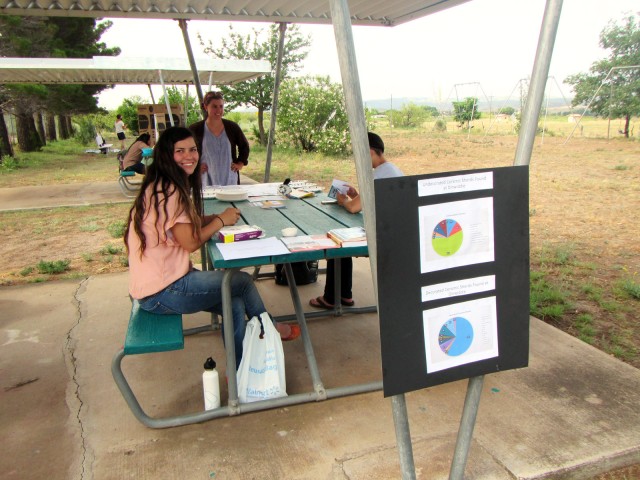
Connor Walsh (University of Notre Dame, IN)
I designed and built a range of wooden bullroarers based on both traditional and experimental designs. I then measured the tone and volume of their voices to examine which patterns and materials produced the loudest or most variable roars. I learned that denser woods produce louder tones, and that irregular or serrated bullroarer designs (which were more difficult to use) generate a broader range of infrasonic tones associated with states of altered consciousness, which may explain their prevalence in ritual contexts.
Thank you to the Gila Library and Community Center for their help and support in organizing the Archaeology Fair; to the owners and employees of the Rocker Diamond X Ranch, our wonderful hosts in Mule Creek; to the owner of the Dinwiddie site for his support of our work there; and to the students and staff of the 2015 Preservation Archaeology Field School for their hard work.
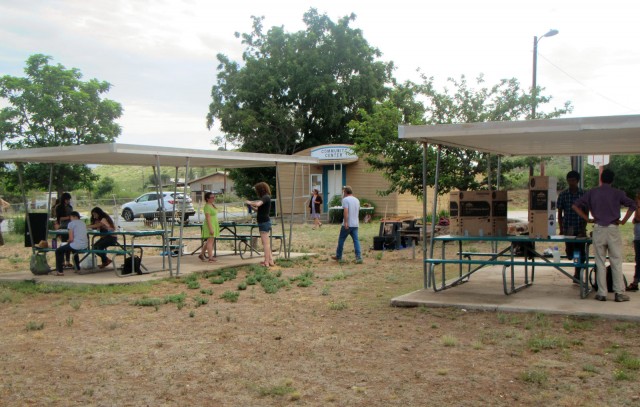
2014 Student Outreach Projects
On June 28, 2014, students in the Archaeology Southwest/University of Arizona Preservation Archaeology Field School shared their research with the community at the Gila Library and Community Center.
Alex Covert (Hobart & William Smith Colleges, NY) and Selena Soto (Grand Valley State U, MI):
We conducted our project on the benefits of archaeological survey. We used maps and handmade dioramas to show that excavations are not always necessary when trying to identify and date archaeological sites.
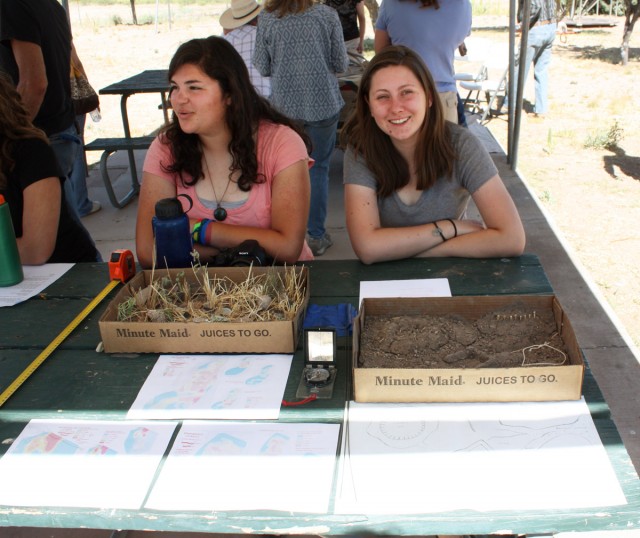
Madisen Dancer (University of Arkansas):
I did a hands-on research project on burden baskets. I not only researched the mythology behind them, but I also made a burden basket with local materials I collected.
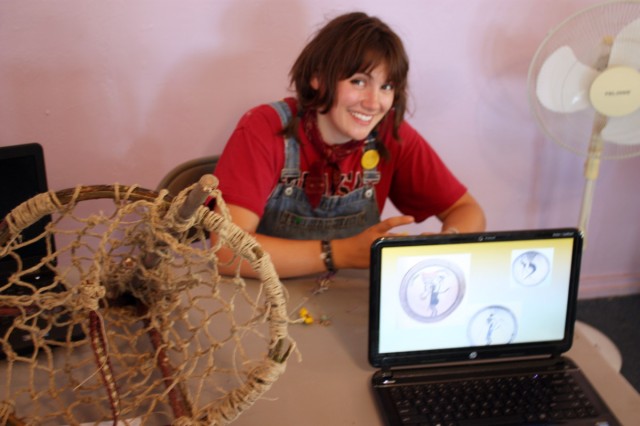
Christopher Davis (University of Colorado Boulder):
My project was an overview of obsidian, including how it forms, its significance within archaeological sites, and geological sourcing. I also discussed how we could use this information to learn about trade patterns and social interactions in the past.
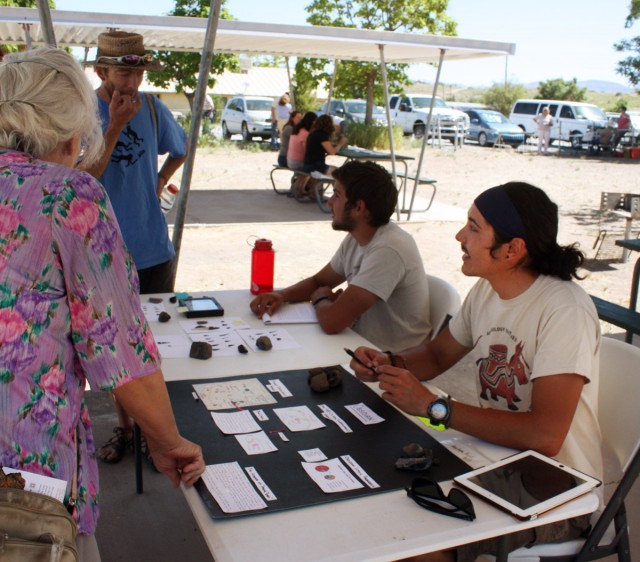
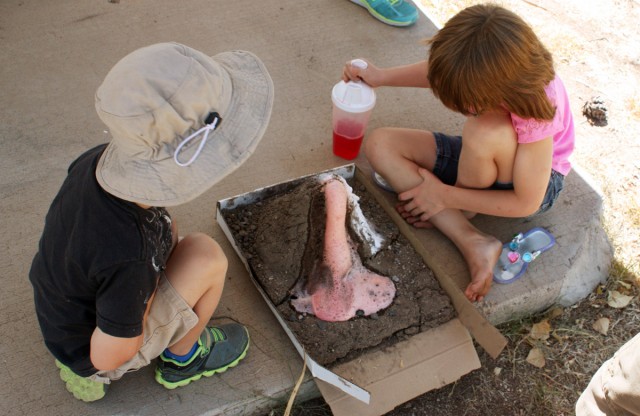
Riley Duke (University of Arizona):
I compared the projectile points found at the 3-Up and Dinwiddie archaeological sites. This comparison provided information about when people lived at each site and about differences in the raw materials the residents had access to.
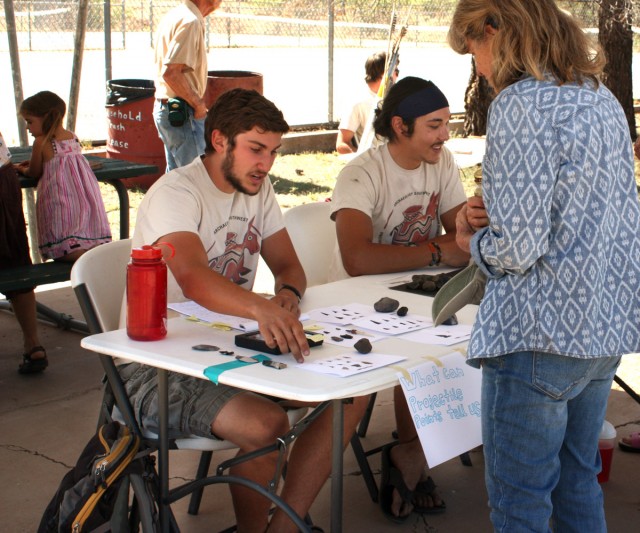
Andrew Finn (Mesa Community College, AZ):
I compared four different types of throwing weapons: the atlatl, baton de commandement, thronged arrow thrower, and rabbit stick. My goal was to educate visitors on the history and use of these weapons through hands-on experience using versions we constructed though experimental archaeology.
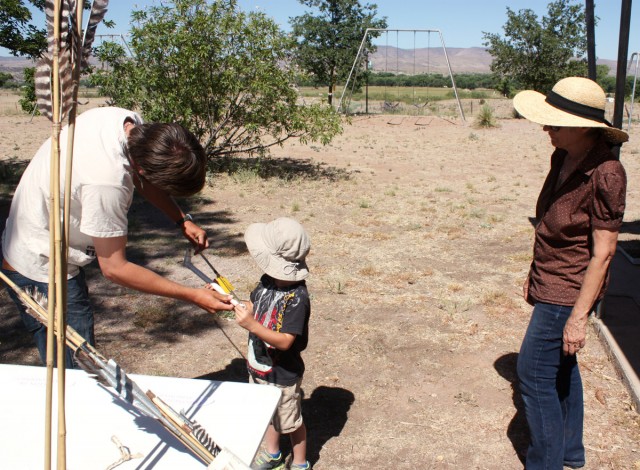
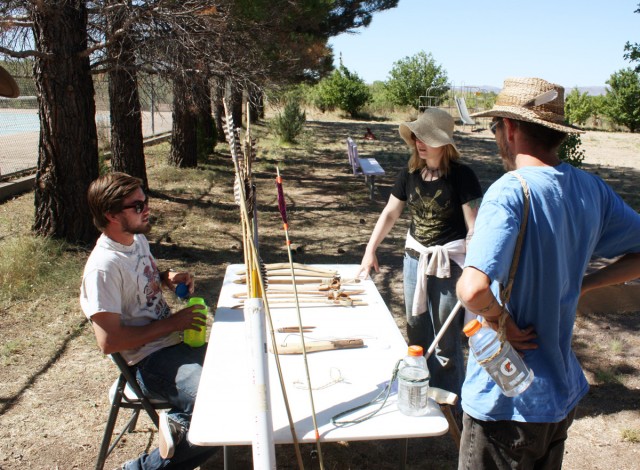
Maxwell Forton (Michigan State University):
My project consisted of identifying Kayenta-style manos and axe heads in the ground stone assemblage at the Dinwiddie site. By examining which rooms had finger-grooved manos and fully grooved axe heads, rather than other forms, we can gauge the possible influence of Kayenta presence at the site.
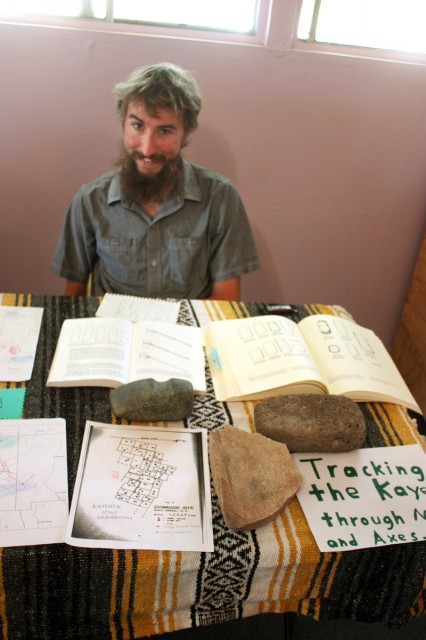
Jacqueline Fox (Arizona State University):
My project researched the various chemical and microscopic means of analyzing and sourcing ceramics, focusing on INAA, PIXE, XRD, and petrography. These processes reveal the elemental and geological components of ceramics to examine where and how they were made, which can provide information on human movement, resources, and trade connections.
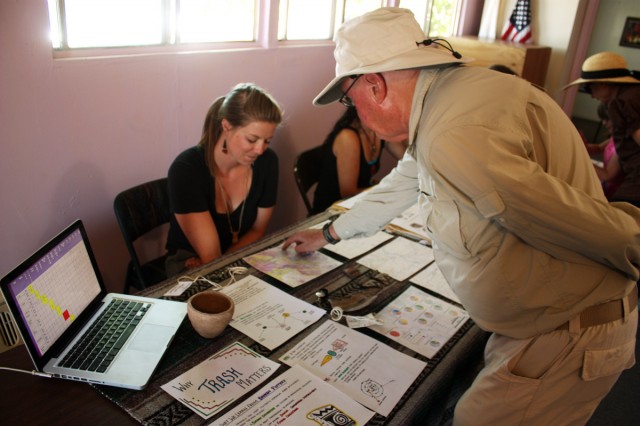
Danielle Gilbert (Arizona State University):
I conducted an experimental archaeology project to better understand the manufacturing process behind Glycymeris shell bracelets. I documented the process of making a bracelet with photos and measurements so that I could identify the use-wear patterns on ground stone and understand the formation of the bracelet.
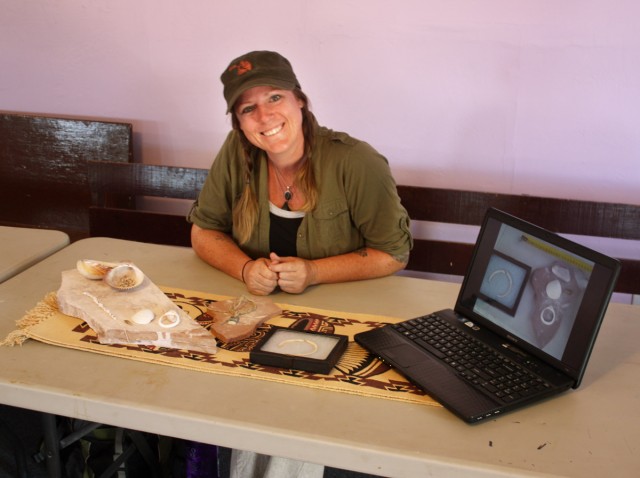
Kaelyn Olson (University of Minnesota-Morris):
I did an experimental archaeology project making cattail mats. Its purpose was to examine wear on the mats and the roles of different weave patterns, and to compare the results to the use of different plants in the region.
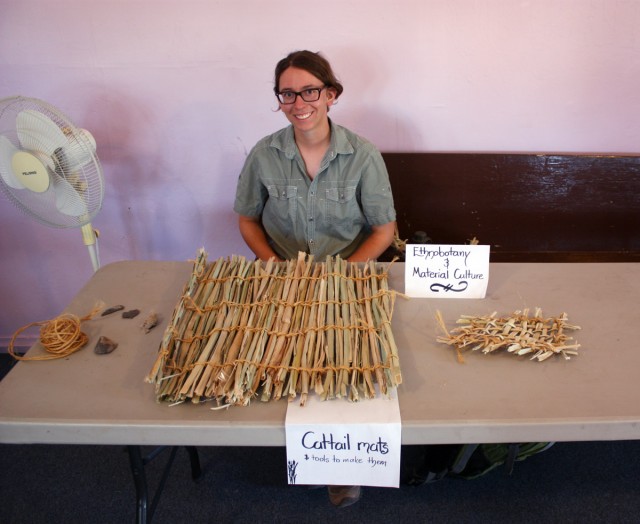
Izzy Starr (Wellesley College, MA):
I examined figurative Mimbres ceramics found at NAN Ranch Ruin, a site in the middle Mimbres valley, to compare their locations within different room blocks at the site. I hypothesized that different types of images might signify horizontal (familial, clan, or moiety) or vertical (elite and common) social stratification with different areas.
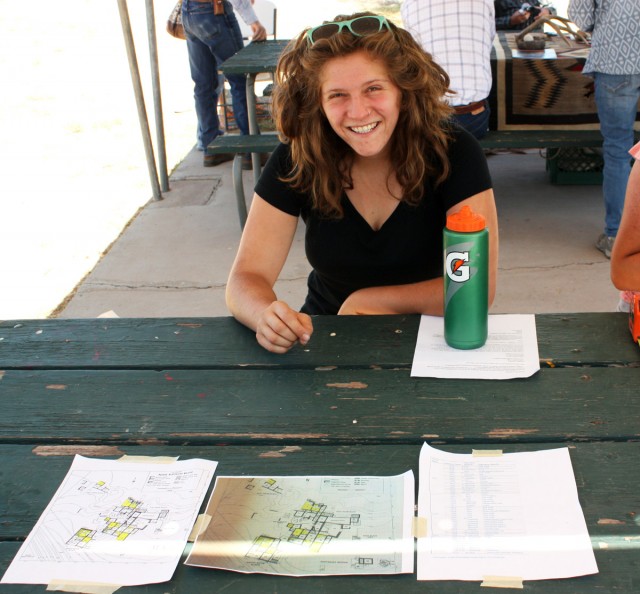
Aaron Trumbo (University of Hawaii Maui College):
I built a cut-away model of an idealized Cliff phase (1300 to 1450) adobe room to study and illustrate ancient construction techniques. The sand and clay used in the adobe mix was locally sourced from Mule Creek.
Erin Verbeck (Vanderbilt University, TN):
I looked at Mimbres pottery to assess whether hachure (repeated lines on pottery) represents water. I examined pottery from NAN Ranch Ruin (in the middle Mimbres Valley) to see whether there were any correlations between the presence of hachure on pottery and social status or sex of individuals found buried at the site.
Hannah Zanotto (Arizona State University):
I examined variations in the types of paint used on Salado polychrome pottery at the Dinwiddie site. By examining carbon vs. mineral paint used on pottery, we can learn more about social interactions and identify northern influences in locally made ceramics.
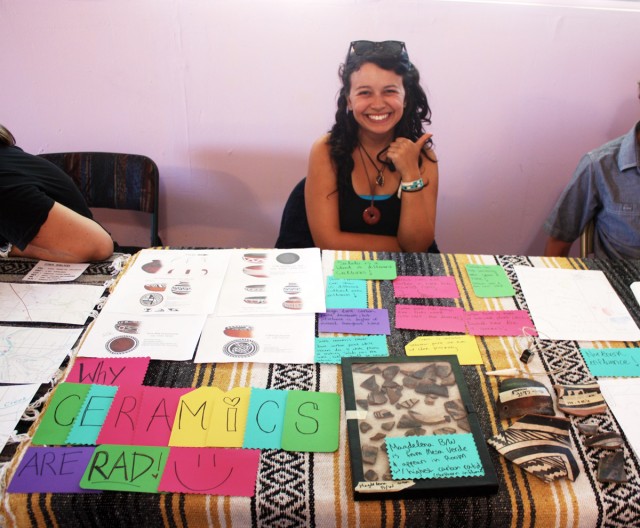
Other displays at the event included a make-your-own jewelry table, where visitors made steatite pendants, a flintknapping demonstration by Allen Denoyer (Archaeology Southwest), and a general archaeology information table.
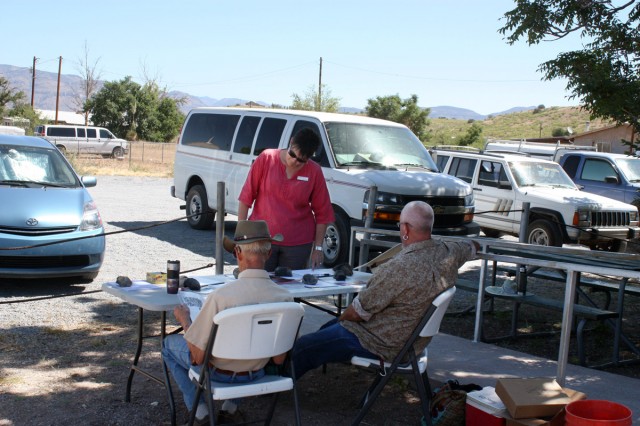
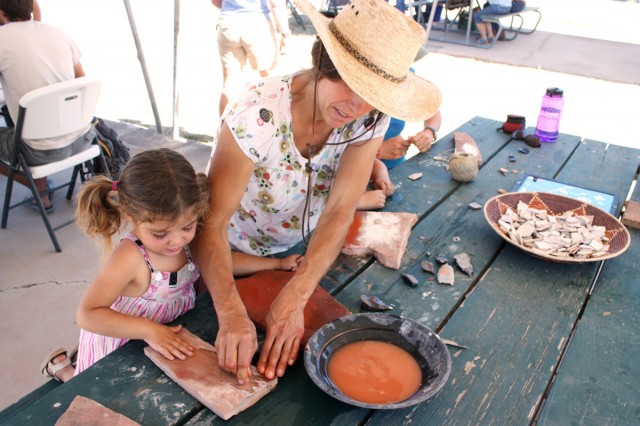
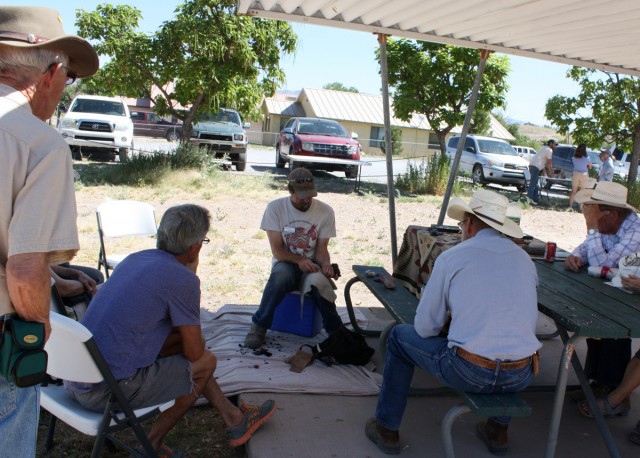
After the event, we gave a tour of excavations in progress at the Dinwiddie site.
